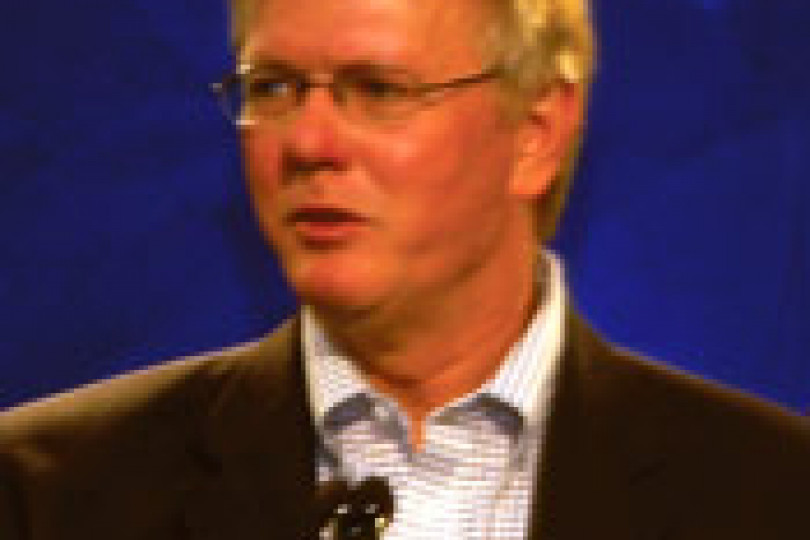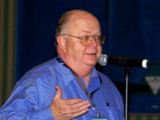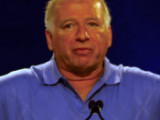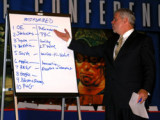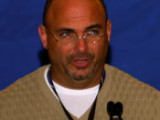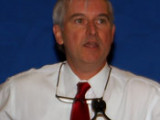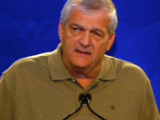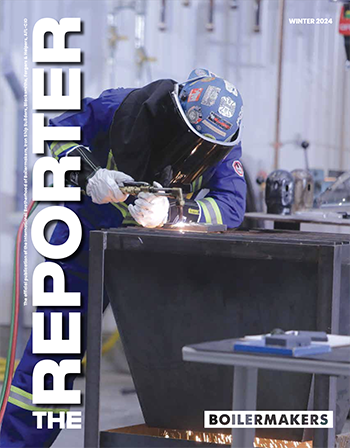IP Newton B. Jones discusses the demand for Boilermaker services.
View Photo Gallery (7 photos)
Alliance seeks solutions to manpower shortage, other challenges
OWNERS, CONTRACTORS, AND the Boilermakers union — partners in the MOST Tripartite Alliance — grappled with the looming manpower shortage and other construction industry challenges at their annual conference in Myrtle Beach, S.C., Oct. 1-4.
It was the first meeting put on entirely by MOST (Mobilization, Optimization, Safety, and Training). Last year MOST assisted the International in running the conference. In previous years, the Boilermakers union had always planned and run the event.
The alliance partners examined problem areas, reviewed recruiting efforts, and received an update on the manpower tracking system. They heard industry consultant Mark Breslin’s proposal for recapturing market share. They listened to Local 154 (Pittsburgh) BM Ray Ventrone describe a new initiative to educate Boilermaker lodges about drug and alcohol intervention. And they learned from a medical doctor about how addiction impairs workers on the job — even when there is no evidence of drugs or alcohol remaining in their systems.
“Which came first, the boiler or the Boilermaker?”
NEARLY TWO MILLION new craft workers will be needed in the United States over the next 10 years, according to recent estimates. Canada will need nearly 200,000.
With such projections, Boilermakers are in high demand. IP Newton B. Jones addressed the issue, noting that skilled craftspeople must have work to sustain them during non-boom periods as well. “It’s like the chicken or the egg — which came first? You can’t build a Boilermaker if you don’t have boilers for him to work on and learn his trade. And if you don’t take care of the Boilermaker, you won’t have a boiler.“
Jones added that if Boilermakers are not used wisely, their ability to produce quality work on demand will be affected. He urged contractors to retain only the welders needed for a given project, so that other contractors will have access to welders, too. He also urged owners to plan outages so they are less likely to occur at the same time, creating a Boilermaker shortage. “You are the drivers of the industry,” he told some 40 owner representatives attending the conference.
Bob Powers, a vice president of Ameren Services, addressed the issue from an owner’s standpoint. “We do need to be more flexible in our outages. We have a national [manpower] shortage,” he agreed. Powers stressed that the degree to which owners can plan environmental projects is affected by the Environmental Protection Agency. “Three quarters of our capital spending over the next seven years is mandated by the EPA. They set the deadlines for when these projects have to be done. We’re competing with each other [owners attending the conference] and with owners around the country for resources.”
Recruiting program, manpower tracking system offer promise
“Everybody [in the owners’ caucus] feels the recruiters are doing a great job, had a great start, but the owners need to get more involved.”
— Larry Wargo
THE TRIPARTITE CONFERENCE discussed two initiatives created to address manpower issues: the MOST recruiting program and the Internet-based Boilermaker National Resources Tracking System.
The recruiting program, now under the direction of AIP Gary Evenson, has shown significant success, said Larry Wargo, speaking on behalf of the owners. Wargo is a consultant for contractor services with FirstEnergy Corp. and Chairman of the Tripartite Committee for Manpower Tracking.
“Everybody [in the owners’ caucus] feels the recruiters are doing a great job, had a great start, but the owners need to get more involved,” Wargo said. “As owners we need to take all of our [MOST] successes to the next level.”
Wargo demonstrated refinements made to the manpower tracking software. The system now includes a sizeable database of Boilermaker members — including their skills and certifications — from various construction lodges. “We are ready to start moving forward with contractor and owner access to this information,” he said. “First we will need to develop protocols for how this access will work.”
The tracking system will provide tripartite partners with up-to-the-minute data showing how Boilermakers are allocated on various projects. It will enable system users to understand demand on local, regional, and national levels and to print custom reports.
Breslin seeks to put union construction on “cutting edge”
“THE CONSTRUCTION INDUSTRY is probably one of the most poorly-managed enterprises in North America,” Mark Breslin told the tripartite conference as he introduced his presentation, titled “The Cutting Edge.” He admitted that his goal is not to make people feel good or to motivate them. Instead, he said his mission is to provoke and challenge those in the unionized construction industry to rethink how they do business — and to make changes.
Breslin hails from a contractor family spanning four generations. He has written two books about unionized construction and has addressed unions and contractors across North America. He has previously addressed Boilermaker audiences, including the construction conference at Marco Island, Fla., in 2006.
Breslin said unions and union contractors lost their dominant position in the industry because they failed to change with the industry’s demands. At one time, unionized construction held an 80 percent market share; that share has dwindled to just 13 percent today, he noted.
Breslin pushed for a dramatic makeover of labor’s market image, citing stereotyping and misinformation as obstacles to overcome.
“The construction industry is probably one of the most poorly-managed enterprises in North America.”
— Mark Breslin, industry
“Our job is to rebuild our business model in accordance to what the market wants,” he said. “What is it that we’re putting out there that is going to return us to market dominance?” Breslin ticked off the qualities union construction can offer: productivity, a flexible work force, extensive training and apprenticeship, skilled supervision, quality job performance, on-time project delivery, focus on a drug-free work force, and a labor-management commitment to greater value.
He asserted that unions and contractors must do a better job of connecting with the rank and file. He said union members/contractor employees are too often left out of the equation, so they work only for the paycheck.
“The cutting edge says we are going to start engaging the rank and file at an interactive level and start talking to them as business people with goals, not blue collar commodities. That’s a jump for a lot of people. I’m here to tell you that I’ve talked to 50,000 of them last year; they are starving to hear from you.” He said the rank and file must understand what is in it for them, and that unions and contractors must show the way.
Breslin addressed the looming manpower shortage as baby boomers retire, describing the shortage as one of the biggest challenges ever faced by the industry. He talked about generational differences and work ethics and how past recruiting methods may not be effective.
He said one new technique is for the union and management to hold a joint job fair. The union handbills industrial facilities in the area, while the employers work the fair. “What this does is it moves the discussion [away] from a union organizer to an applicant coming in and seeing 20 contractors at tables recruiting the next Boilermaker, the next welder, the next specialist that they need. In one market, in one night, they got 260 qualified nonunion journeymen and signed them up. Friday morning they all go in for drug testing and orientation, and Monday morning they all [those that qualify] go to work, with a new employer and a new job — with labor and management working together to solve a problem.”
L-154 announces education for drug/alcohol intervention
RAY VENTRONE, BM for Local 154 (Pittsburgh) told tripartite members his lodge will help form a new MOST committee to educate other locals on how to set up member assistance programs for help with drug and alcohol addiction.
Local 154 is proactive in dealing with drugs in the workplace, and has been for a number of years, Ventrone said. The lodge established a drug hotline for members and families to call, and it provides regular member education on drug-related topics, including how to get help. In addition, Local 154 has arranged for treatment services with a rehabilitation center that has shown excellent results in getting members back to work clean and sober.
“Drug addiction affects the owner community, the union, and the contractors,” Ventrone noted. “Oftentimes, chronic absenteeism is a key factor in identifying a person with an addiction. We all know that absenteeism is a problem out there; it is a problem across the country and across all trades.”
Ventrone thanked IP Jones for supporting the idea of a drug education committee. “President Jones told me: ‘Ray, if we save one guy’s life, we’ve done our job.’”
Ventrone also acknowledged the efforts of IVP George Rogers and other trustees on the National Health & Welfare Trust for raising the lifetime maximum benefit for drug and alcohol treatment from $30,000 to $50,000.
MOST administrator Bill Palmisano reminded the alliance partners of the importance of drug testing. “We’ve been drug testing since 1991,” he said. “Unless you implement the random portion of this program, you don’t have a program. As contractors, you should implement, and as owners you should demand [random testing].”
Addiction specialist dispels drug myths
“FOOD, SEX, AND drugs are all the same thing to our brain,” asserted Dr. Brendan Adams, M.D., a specialist in addiction who addressed the conference. He said all three trigger a release of dopamine, a naturally occurring hormone associated with feelings of pleasure. It is this stimulation of the brain that addicts repeatedly seek to achieve.
Dr. Adams said he has worked closely with IVPs Joe Maloney (Western Canada) and Ed Power (Eastern Canada) on drug education.
“Drugs that can be smoked or injected are typically addictive drugs, but, statistically speaking, alcohol is still the most dangerous,” he said. “Ten percent of the population is alcoholic.”
With so much information available, and from so many sources, Dr. Adams said a number of myths have arisen, such as drugs being harmless, that they help people relax, or that they enhance sex.
None of these myths are true, he said. He stressed that, on the job, the question becomes one of, “What is impairment?”
“Marijuana is crappy medicine. It has been linked to schizophrenia and depression.”
— Dr. Brendan Adams
“Impairment is quite different than intoxication. There are other forms of impairment besides slurred speech and staggering. These may include lack of attention, irritability, and sleepiness. A sleepy worker isn’t a safe worker; his head is not in the moment.”
One of the drugs shrouded in myth is marijuana, Dr. Adams said. Many people argue that it has helpful medicinal properties. Not so, says the doctor. “Marijuana is crappy medicine. It has been linked to schizophrenia and depression.”
Dr. Adams also described the dangers of new synthetic drugs, some of which make a person feel drunk quickly, and can cause one to slip into a coma.
Take advantage of MOST, say participants
A RECURRING COMMENT from many attending the conference was the need for contractors and owners to take advantage of the various MOST programs.
“We’ve got the best program in the building trades,” IVP Sean Murphy told the conference. “Everybody’s out there copying what we’re doing. Don’t reinvent the wheel, implement what we’re doing. The whole Northwest Ohio building trades is utilizing MOST. It works. We can make it work for you owners if you give us the opportunity. And it’s cheaper [than creating new programs].”
Palmisano echoed Murphy’s comments. “Look around you at the 16 banners in this room. Those 16 banners represent the MOST program. Everybody that’s in this room is a member of that family. It’s your program, you’re paying for it. You deserve it. Use it.”
One way that MOST is being better utilized is through area and local tripartite committees. Six committees reported on their activities, including IVP Murphy, Northeast Area; IVP Power, Eastern Canada; IR Marty Stanton II, Ohio Valley; IR Tony Palmisano, Upper Midwest; AIP Kyle Evenson, Western States; and IVPs Rogers and Sam May, Central Section/Southeast Area.
Wargo said the owners’ caucus discussed area and local tripartite successes. “We heard amazing stories from some of the ones that are really coming along…and some that are just getting started.”
